
Waupaca County is a county in the U.S. state of Wisconsin. As of the 2020 census, the population was 51,812. The county seat is Waupaca. The county was created in 1851 and organized in 1853. It is named after the Waupaca River, a Menominee language name meaning 'white sand bottom', 'pale water', or 'tomorrow river'.
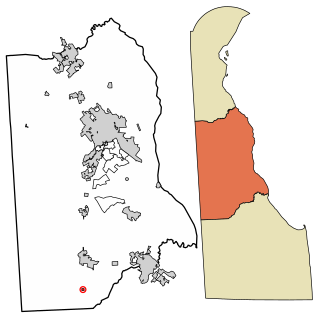
Farmington is a town in Kent County, Delaware, United States. It is part of the Dover, Delaware Metropolitan Statistical Area. The population was 92 in 2020.

Farmington is a city in St. Francois County located about 75 miles (121 km) southwest of St. Louis in the Lead Belt region in Missouri. As of the 2020 census, the population was 18,217. It is the county seat of St. Francois County. Farmington was established in 1822 as Murphy's Settlement, named for William Murphy of Kentucky, who first visited the site in 1798. When St. Francois County was organized, the town was briefly called St. Francois Court House and later renamed to Farmington.
Farmington is a town located in the northern part of Ontario County, New York, United States. The population was 14,275 at the 2020 census.

Farmington is a town in Washington County, Wisconsin, United States. The population was 3,239 at the 2000 census. The unincorporated communities of Boltonville, Cheeseville, Fillmore, and Orchard Grove are located in the town. The unincorporated community of Saint Michaels is also located partially in the town.
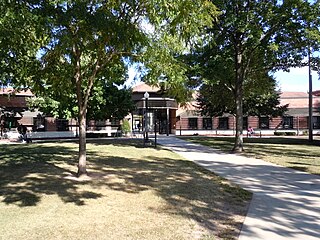
Waupaca is a city in and the county seat of Waupaca County in the U.S. state of Wisconsin. The population was 6,282 at the 2020 census.

William Munford Tuck was an American lawyer and lieutenant in the Byrd Organization, who served as the 55th Governor of Virginia from 1946 to 1950 as a Democrat, and as a U.S. Congressman from 1953 until 1969.

The Lincoln Log Cabin State Historic Site is an 86-acre (0.3 km²) history park located eight miles (13 km) south of Charleston, Illinois, U.S., near the town of Lerna. The centerpiece is a replica of the log cabin built and occupied by Thomas Lincoln, father of U.S. President Abraham Lincoln. Abraham Lincoln never lived here and only occasionally visited, but he provided financial help to the household and, after Thomas died in 1851, Abraham owned and maintained the farm for his stepmother, Sarah Bush Lincoln. The farmstead is operated by the Illinois Historic Preservation Agency.
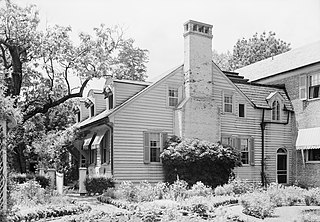
Oxmoor Farm is an estate in Louisville, Kentucky located 8 miles (13 km) east of downtown. It was listed on the National Register of Historic Places in 1976. It has also been termed Oxmoor or the Bullitt Estate.

The Bray Place in Louisville, Kentucky refers to the early farmstead and home built in 1796 by Major Samuel E. Bray and his wife, Nancy Lyle Bray from Virginia. The 210 acres (85 ha) was granted by Thomas Jefferson to Bray as payment for serving in the Revolutionary War and surveying what was then Virginia. It was bordered by what is now Bardstown Road, Goldsmith Lane and Hikes Lane. The original neighbors were Edward Hikes, Andrew Hikes, and John & Lucy Speed who were parents of Joshua & James Speed. Abraham Lincoln visited the area in August, 1841 for 3 weeks after breaking his engagement with Mary Todd due to her parents’ disapproval of the match. The visit to Farmington and the neighboring Bray family restored his happiness and was known to be one of the happiest times of his life.

Katharine Elizabeth Dopp was one of the foremost American educators at the turn of the 20th century, and one of the first to advocate the involvement of business in education. She wrote a series of textbooks on anthropology and economics which were widely used in the public schools of Wisconsin, Illinois and Utah, as well as nationally circulated studies on the same subjects, and children's books.

This is a list of the National Register of Historic Places listings in Waupaca County, Wisconsin. It is intended to provide a comprehensive listing of entries in the National Register of Historic Places that are located in Waupaca County, Wisconsin. The locations of National Register properties for which the latitude and longitude coordinates are included below may be seen in a map.
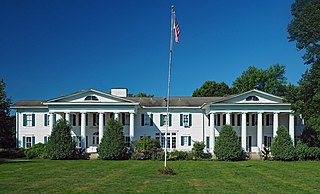
The Cordenio Severance House is a mansion in Cottage Grove, Minnesota, United States, built for attorney Cordenio Severance (1862–1925). The mansion, also known as Cedarhurst, was first built as a simple country farm house shortly after the American Civil War. It was expanded in 1886 to serve as the summer residence of the Severance family. Between 1911 and 1917, additions designed by architect Cass Gilbert expanded the house into a mansion with 12,000 square feet (1,100 m2) and 26 rooms. The Cordenio Severance House was listed on the National Register of Historic Places in 1976 for its local significance in the themes of architecture and law. It was nominated for its association with Cordenio Severance, a leading attorney in Saint Paul, Minnesota, from 1887 to the 1920s, and for being an example of a grand country estate. The mansion now serves as an event venue.

King is a census-designated place in Town of Farmington, Waupaca County, Wisconsin. As of the 2010 census, it had a population of 1,750. Before 2010, it was part of the Chain O' Lakes-King, Wisconsin CDP.

This is a list of the National Register of Historic Places listings in Portage County, Wisconsin. It is intended to provide a comprehensive listing of entries in the National Register of Historic Places that are located in Portage County, Wisconsin. The locations of National Register properties for which the latitude and longitude coordinates are included below may be seen in a map.

The Danes Hall in Waupaca, Wisconsin, United States, was built in 1894 as a gathering place for the Danes Home Society. It served historically as a clubhouse, as a meeting hall, and as an auditorium. The upper floor consists of a dance hall with a balcony. It was listed on the National Register of Historic Places in 1980.
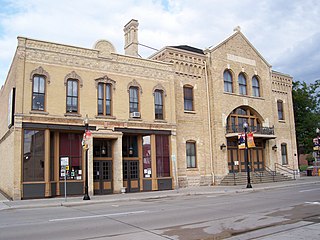
William Waters (1843–1917) was an American architect who designed numerous buildings in Wisconsin that eventually were listed on the National Register of Historic Places. He was responsible for designing much of historic Oshkosh, Wisconsin. He was also responsible for designing the Wisconsin building for the Columbian Exposition. Waters died in 1917 and is buried at Riverside Cemetery in Oshkosh. After his death, Oshkosh honored him by naming the intersection of Washington Avenue and State Street as the "William Waters Plaza".

St. John of God Roman Catholic Church, Convent, and School is a historic church near the unincorporated community of Boltonville in the Town of Farmington, Wisconsin. The church was built from Cream City brick in 1891, although the congregation has existed since the 1850s.
Joseph Henry Woodnorth was an American merchant and Democratic politician. He was a member of the Wisconsin State Senate, representing Shawano, Waupaca, and eastern Marathon counties during the 1891 and 1893 sessions. He also served in the Union Army during the American Civil War and received an honorary brevet to captain.

















